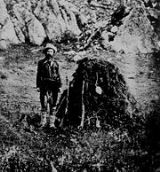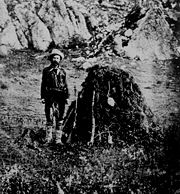
Valentine McGillycuddy
Encyclopedia

United States
The United States of America is a federal constitutional republic comprising fifty states and a federal district...
and the Native American
Native Americans in the United States
Native Americans in the United States are the indigenous peoples in North America within the boundaries of the present-day continental United States, parts of Alaska, and the island state of Hawaii. They are composed of numerous, distinct tribes, states, and ethnic groups, many of which survive as...
people. As the surveyor for the Newton-Jenney Party
Newton-Jenney Party
The Newton–Jenney Party of 1875, led by Henry Newton and Walter P. Jenney, and escorted by a military detachment led by Lieutenant Colonel Richard I. Dodge. Also known as the Jenney-Newton Party, it was a scientific expedition sponsored by the United States Geological Survey to map the Black Hills...
, McGillycuddy was the first known person to climb Harney Peak
Harney Peak
Harney Peak is the highest natural point in South Dakota. Harney Peak is located within the Black Elk Wilderness area, in southern Pennington County, within Black Hills National Forest...
in the Black Hills
Black Hills
The Black Hills are a small, isolated mountain range rising from the Great Plains of North America in western South Dakota and extending into Wyoming, USA. Set off from the main body of the Rocky Mountains, the region is something of a geological anomaly—accurately described as an "island of...
of South Dakota
South Dakota
South Dakota is a state located in the Midwestern region of the United States. It is named after the Lakota and Dakota Sioux American Indian tribes. Once a part of Dakota Territory, South Dakota became a state on November 2, 1889. The state has an area of and an estimated population of just over...
. He then served as Contract Surgeon with General George Crook
George Crook
George R. Crook was a career United States Army officer, most noted for his distinguished service during the American Civil War and the Indian Wars.-Early life:...
during the Battle of the Rosebud
Battle of the Rosebud
The Battle of the Rosebud occurred June 17, 1876, in the Montana Territory between the United States Army and a force of Lakota Native Americans during the Black Hills War...
, the Battle of Slim Buttes
Battle of Slim Buttes
The Battle of Slim Buttes was fought on September 9–10, 1876, in the Great Sioux Reservation between the United States Army and Miniconjou Sioux during the Great Sioux War of 1876...
, and the Horsemeat March
Horsemeat March
The Horsemeat March of 1876, also known as the Starvation March, was a military expedition led by General George Crook in pursuit of a band of Sioux fleeing General Custer's defeat at the Battle of Little Big Horn. In September, after the battle of Slim Buttes, the Sioux burned the grass behind...
.
As Assistant Post Surgeon at Fort Robinson
Fort Robinson
Fort Robinson is a former U.S. Army fort and a present-day state park. Located in the Pine Ridge region of northwest Nebraska, it is west of Crawford on U.S. Route 20.- History :...
and later as Indian Agent
Indian agent
In United States history, an Indian agent was an individual authorized to interact with Native American tribes on behalf of the U.S. government.-Indian agents:*Leander Clark was agent for the Sac and Fox in Iowa beginning in 1866....
for the Red Cloud Agency
Red Cloud Agency
The Red Cloud Agency was an Indian agency for the Oglala Lakota as well as the Northern Cheyenne and Arapaho, from 1871 to 1878. It was located at three different sites in Wyoming Territory , before being moved to South Dakota. It was then renamed the Pine Ridge Reservation.- Red Cloud Agency No...
, McGillycuddy was known to the Lakota of the modern-day Pine Ridge Indian Reservation
Pine Ridge Indian Reservation
The Pine Ridge Indian Reservation is an Oglala Sioux Native American reservation located in the U.S. state of South Dakota. Originally included within the territory of the Great Sioux Reservation, Pine Ridge was established in 1889 in the southwest corner of South Dakota on the Nebraska border...
as "Friend of Crazy Horse
Crazy Horse
Crazy Horse was a Native American war leader of the Oglala Lakota. He took up arms against the U.S...
", and was the doctor who treated Crazy Horse at the time of his death.
While he may have been a friend to Crazy Horse, he was not so much loved by some other Lakotas, including Red Cloud
Red Cloud
Red Cloud , was a war leader and the head Chief of the Oglala Lakota . His reign was from 1868 to 1909...
, a major Sioux
Sioux
The Sioux are Native American and First Nations people in North America. The term can refer to any ethnic group within the Great Sioux Nation or any of the nation's many language dialects...
chief. Red Cloud's accusations of mismanagement led to several investigations of Dr. McGillycuddy's administration. Under pressure to arbitrarily fire a loyal clerk, Dr. McGillycuddy eventually resigned his post. Later, in the days leading up to the Wounded Knee Massacre
Wounded Knee Massacre
The Wounded Knee Massacre happened on December 29, 1890, near Wounded Knee Creek on the Lakota Pine Ridge Indian Reservation in South Dakota, USA. On the day before, a detachment of the U.S. 7th Cavalry Regiment commanded by Major Samuel M...
, Red Cloud
Red Cloud
Red Cloud , was a war leader and the head Chief of the Oglala Lakota . His reign was from 1868 to 1909...
conceded that McGillycuddy had been a "young man with an old man's head on his shoulders."
Dr. McGillycuddy would later serve as mayor of Rapid City
Rapid City, South Dakota
Rapid City is the second-largest city in the U.S. state of South Dakota, and the county seat of Pennington County. Named after Rapid Creek on which the city is established, it is set against the eastern slope of the Black Hills mountain range. The population was 67,956 as of the 2010 Census. Rapid...
, Dean of the South Dakota School of Mines and Technology
South Dakota School of Mines and Technology
The South Dakota School of Mines and Technology is a public institution of higher learning in Rapid City, South Dakota governed by the South Dakota Board of Regents. Founded in 1885 as the Dakota School of Mines, Tech offers degree programs in engineering and science fields. 2,354 students were...
, delegate to the South Dakota State Constitutional Convention, and as South Dakota's first State Surgeon General
State Surgeon General
A State Surgeon General is the operational head and senior spokesperson on public health in a single state of the United States of America, the state equivalent of the Surgeon General of the United States....
. The mansion that he built in 1888 is still standing today in Rapid City.
McGillycuddy died at age 90 in Berkeley
Berkeley, California
Berkeley is a city on the east shore of the San Francisco Bay in Northern California, United States. Its neighbors to the south are the cities of Oakland and Emeryville. To the north is the city of Albany and the unincorporated community of Kensington...
, California
California
California is a state located on the West Coast of the United States. It is by far the most populous U.S. state, and the third-largest by land area...
. His ashes
Cremation
Cremation is the process of reducing bodies to basic chemical compounds such as gasses and bone fragments. This is accomplished through high-temperature burning, vaporization and oxidation....
are entombed at the top of Harney Peak
Harney Peak
Harney Peak is the highest natural point in South Dakota. Harney Peak is located within the Black Elk Wilderness area, in southern Pennington County, within Black Hills National Forest...
behind a plaque that reads "Valentine McGillycuddy, Wasitu Wacan (Lakota: translates as Holy White Man)."
Books based on Valentine McGillycuddy's life include:
- McGillycuddy, Agent (Julia McGillycuddy, 1942); later republished as Blood on the Moon
- Contract Surgeon (Dan Obrien, 2001)
- Indian Agent (Dan Obrien, 2005)
- Heroes Without Glory: Some Goodmen of the Old West (Jack Schaefer, 1965)
Museum and archival collections
- Journey Museum, Rapid City, South Dakota
- State Historical Archives, Pierre, South DakotaPierre, South DakotaPierre is the capital of the U.S. state of South Dakota and the county seat of Hughes County. The population was 13,646 at the 2010 census, making it the second least populous state capital after Montpelier, Vermont...
- University of South Dakota, Vermillion, South DakotaVermillion, South DakotaVermillion is a city in and the county seat of Clay County, in the southeastern corner of the U.S. state of South Dakota, and the tenth largest city in the state. According to the 2010 Census, the population was 10,571. Vermillion lies atop a bluff near the Missouri River.The area has been home to...
- McGillycuddy House, Rapid City, South DakotaRapid City, South DakotaRapid City is the second-largest city in the U.S. state of South Dakota, and the county seat of Pennington County. Named after Rapid Creek on which the city is established, it is set against the eastern slope of the Black Hills mountain range. The population was 67,956 as of the 2010 Census. Rapid...
- South Dakota School of Mines and Technology, Rapid City, South Dakota
- Fort Robinson Historical Museum, Fort Robinson, NebraskaNebraskaNebraska is a state on the Great Plains of the Midwestern United States. The state's capital is Lincoln and its largest city is Omaha, on the Missouri River....
- National Anthropological Archives, Smithsonian InstitutionSmithsonian InstitutionThe Smithsonian Institution is an educational and research institute and associated museum complex, administered and funded by the government of the United States and by funds from its endowment, contributions, and profits from its retail operations, concessions, licensing activities, and magazines...
, Suitland, MarylandMarylandMaryland is a U.S. state located in the Mid Atlantic region of the United States, bordering Virginia, West Virginia, and the District of Columbia to its south and west; Pennsylvania to its north; and Delaware to its east...

